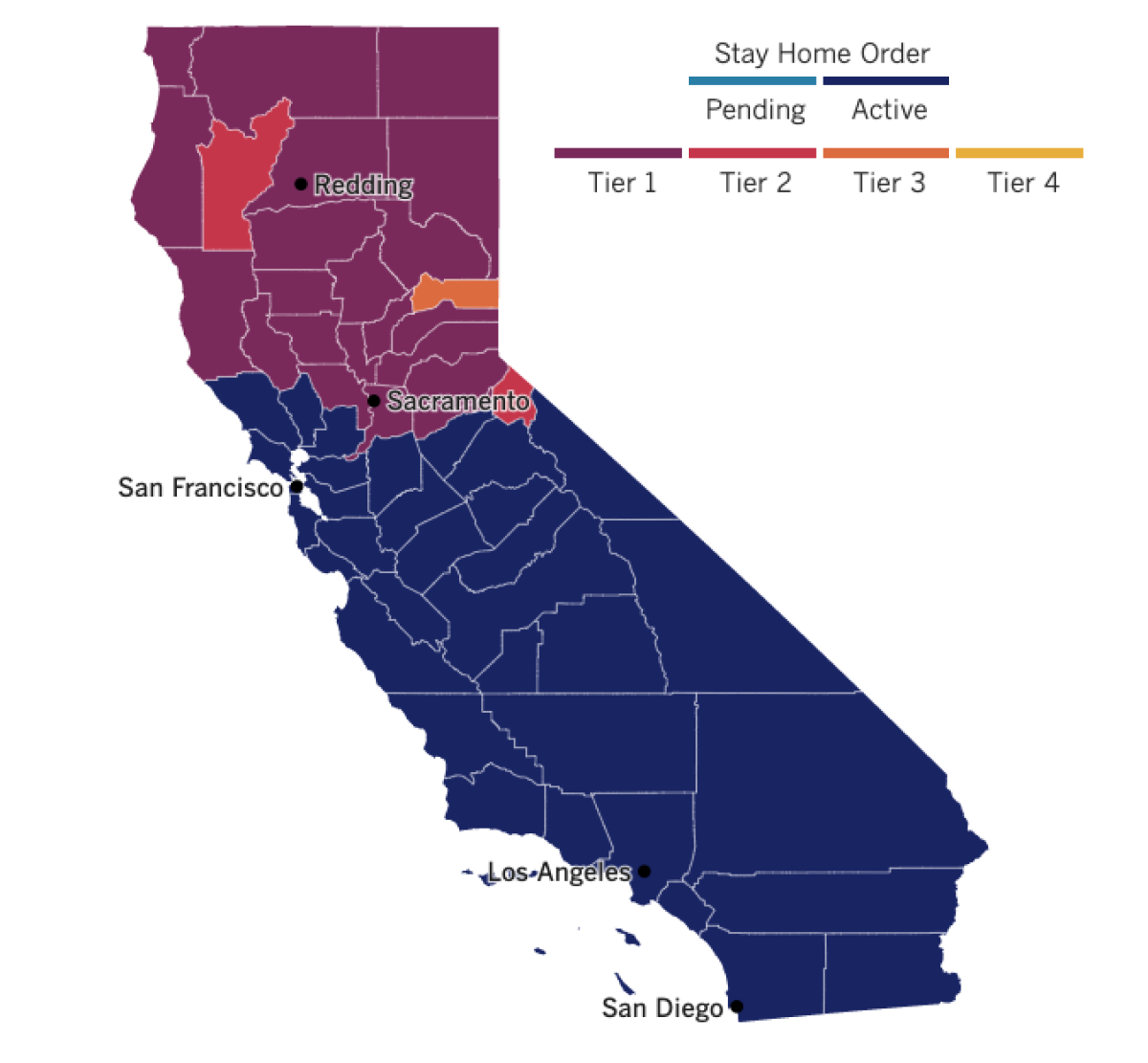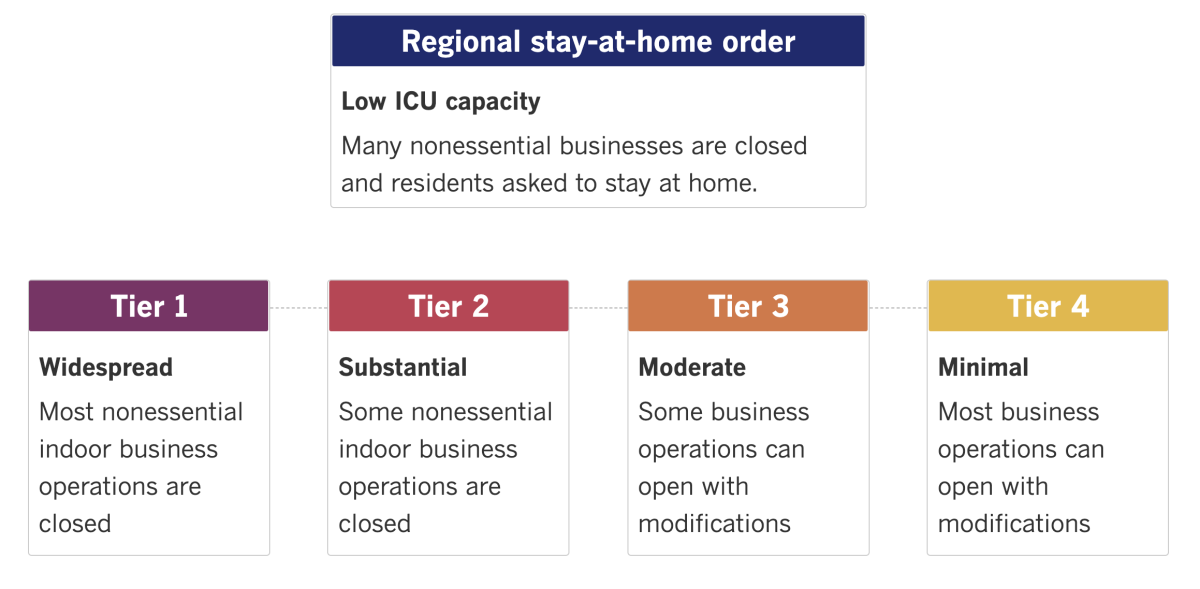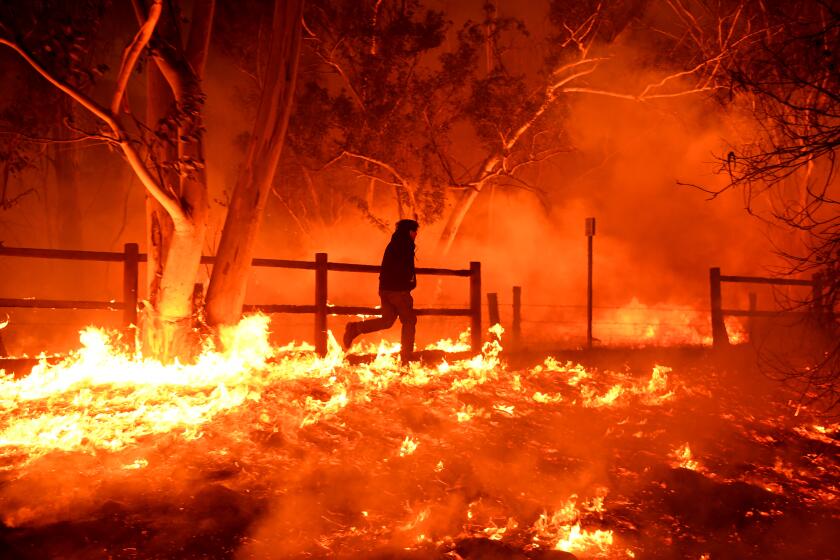Coronavirus Today: The mutation equation
- Share via
Good evening. I’m Amina Khan, and it’s Wednesday, Jan. 20. Here’s what’s happening with the coronavirus in California and beyond.
For the record:
5:49 p.m. Jan. 21, 2021This newsletter originally gave the wrong lot number for doses of Moderna vaccines that are being investigated for causing possible allergic reactions. The lot in question is 041L20A, not 021L20A.
The coronavirus is becoming more genetically diverse, thanks in large part to the high number of new cases, officials say. Every new infection gives the virus an opportunity to mutate as it makes copies of itself — and in theory, all it takes is one mutation to undo the progress that’s been made toward controlling the pandemic.
As many Americans ignored coronavirus restrictions, refused to wear masks, boarded planes and attended gatherings over the holiday season, they were helping to create fertile ground for that scenario to take root. And their unwitting efforts may already be bearing fruit: Several viruses with worrisome genetic changes are circulating in the U.S. and around the world.
One of them is B.1.1.7, a coronavirus variant first identified in the U.K. that has been reported in at least 30 countries, including the United States. B.1.1.7 is circulating in Los Angeles, San Diego and San Bernardino counties, and while it’s not yet one of the dominant strains in California, that could change soon.
B.1.1.7 is not more virulent than its predecessors, but scientists say it’s about 50% more contagious. This means it could spread to more people before it is stopped by a vaccine — which would inevitably lead to an increase in hospitalizations and deaths.
Researchers at Cedars-Sinai Medical Center this week raised the possibility that another new variant, which they call CAL.20C, could be fueling the recent surge in cases in Southern California. Over the past two months, about a third of coronavirus infections at the medical center were due to CAL.20C, as were 24% of samples from throughout Southern California, the researchers wrote in a paper posted on a website for sharing work that has not yet been published in a peer-reviewed medical journal. The variant has also been detected in Northern California, New York and Washington, D.C. Researchers don’t know whether it spreads more easily or makes those it infects sicker.
In Northern California, a viral variant with at least one of the same key mutations has been cropping up more often in recent testing, researchers say. It was identified in 4% of virus samples examined in late November and early December, but its prevalence shot up to 25% between mid-December and early January.
“This is why it’s concerning,” said Dr. Charles Chiu, virologist and professor of laboratory medicine at UC San Francisco, who calls the variant L452R because that’s the name of its most significant mutation. “It is concerning that it may potentially be more infectious.”
On Friday, the World Health Organization called for stepped-up efforts to detect new variants. And the Centers for Disease Control and Prevention warned that B.1.1.7 could become dominant in the U.S. by March, fueling “a new phase of exponential growth.”
“We need to do everything we can now ... to get transmission as low as we possibly can,” said Dr. Michael Mina, an infectious disease specialist at Harvard University. “The best way to prevent mutant strains from emerging is to slow transmission.”
While the COVID-19 vaccines authorized so far seem to be effective against these variants, there are signs that some of the new mutations may undermine the accuracy of coronavirus tests and reduce the effectiveness of certain treatments.
“We’re in a race against time” because the virus “may stumble upon a mutation” that makes it more dangerous, said Pardis Sabeti, an evolutionary biologist at the Broad Institute of MIT and Harvard.
Among the contributors to the virus’ proving grounds are young people who may be less willing to wear masks, avoid crowds and take other steps to avoid infection simply because the current strain doesn’t seem to make them very sick. But “in one mutational change, it might,” Sabeti said.
And that’s another reason to be concerned about the slow start to the U.S.’s COVID-19 vaccination campaign: The longer it takes to get doses into Americans’ arms, the more likely it is that a seriously dangerous variant will emerge.
It’s a problem brilliantly — and darkly — summed up by this satirical piece from the Onion, in which an imagined spokesperson for COVID-19 thanks Americans’ “concerted national effort” to aid the speedy rollout of an easily transmissible new strain.
By the numbers
California cases, deaths and vaccinations as of 5:40 p.m. PST Wednesday:

Track the latest numbers and how they break down in California with our graphics.
Across California
Gov. Gavin Newsom’s finance agency may have shortchanged California’s smaller communities when it doled out federal COVID-19 relief money, according to a state audit released Tuesday. The report found that relief funds for 16 of the state’s most populous counties totaled at least $190 per resident — a combination of what they received directly from D.C. and what was later rationed out by state officials — while 42 counties with fewer residents received only $102 per person.
The California Department of Finance explained the discrepancy by saying that large counties had higher transmission rates and so needed more money. But the audit finds fault with that reasoning, pointing to the harsh pandemic conditions in places like Imperial County and Kings County.
The findings, issued by State Auditor Elaine Howle, concluded that the Newsom administration’s methodology was overly generous to those 16 counties, “resulting in them receiving nearly double the total per person amount of [federal] funding” compared with the other 42. They also flagged shortcomings in the process used by the Governor’s Office of Emergency Services to determine whether cities had defied state public health orders and should be stripped of their share of relief funds. The agency “could not demonstrate that it used a consistent process for conducting such evaluation” of all of the state’s 476 cities, the auditors wrote.
Meanwhile, Los Angeles County has opened five large-scale coronavirus vaccination sites with a goal of inoculating 20,000 people daily. The sites are at the Forum in Inglewood, Six Flags Magic Mountain in Valencia, Cal State Northridge, the Fairplex in Pomona and the L.A. County Office of Education’s Downey Education Center. Another site, run by the city of Los Angeles, is up and running at Dodger Stadium.
Only front-line healthcare workers were eligible to get the shots when the county sites opened Tuesday morning, officials said. But later that day, county officials announced that residents 65 and older could sign up for appointments — though they warned that the vaccine supply is “extremely limited.”
It will take time to vaccinate all 1.3 million residents in this age group, officials said. “We do not have enough of the COVID-19 vaccine for everyone,” said L.A. County Board of Supervisors Chair Hilda Solis. “That includes all those 65 and older, but we will get there. Patience.”
A lot of patience. Vaccinating all Californians 65 and over could take until June to complete, state epidemiologist Dr. Erica Pan said Wednesday, raising new concerns about when other groups will be eligible. That timetable would push back vaccine access for people not currently on the priority list for at least four months, based on her estimate at a vaccine advisory committee meeting.
The current pace could change if the federal government speeds up shipments beyond the current rate of 300,000 to 500,000 doses each week, Pan said. So far, the state has received roughly 4 million vaccine doses from the federal government.
But officials aren’t expecting a significant jump in their weekly allotment of vaccine in the near future, said Dr. Seira Kurian, director of the L.A. County Health Department’s Division of Medical Affairs. Officials originally thought the federal government had vaccine stockpiles that would be delivered once counties needed them to administer second doses. But now “it’s unclear how much, if any, of those reserves are available,” Kurian said.
In Orange County, COVID-19 vaccination plans ran into trouble as high winds forced a two-day closure of the Disneyland vaccination site in Anaheim on Tuesday and Wednesday. Thousands of people who were scheduled to receive their first vaccine, including residents 65 and older, were notified of the temporary cancellation through the Othena app. A county official said that people who were originally scheduled to be vaccinated Tuesday have had their appointments moved to Thursday.
In a further snag to the county’s vaccine rollout, a batch of Moderna vaccines given to more than 5,000 residents is being investigated for causing possible allergic reactions. Moderna, the CDC and the U.S. Food and Drug Administration are conducting the inquiry, and residents are being advised to check their vaccination cards to see if their doses came from lot number 041L20A. Any adverse reactions should be reported to a doctor or primary care provider, the OC Health Care Agency said. “To date, the HCA has received zero notifications of allergic reactions requiring medical attention due to any Moderna vaccines,” officials added.
Up in San Francisco, officials say they will run out of COVID-19 vaccine Thursday because the city’s allocation dropped significantly from a week prior, and because suspect Moderna doses that had to be discarded were not replaced.
Dr. Grant Colfax, San Francisco’s director of public health, said the city received 12,000 doses a week ago and asked for the same number this week — but only 1,775 doses came in. On top of that, the city received 8,000 doses of Moderna vaccine that had to be discarded, he said.
Local health officials all over California have said it’s difficult to schedule vaccine appointments for residents because it’s unclear how much vaccine they will receive from week to week. As of Friday, California had administered vaccines to only 2,190 residents per 100,000 people. For comparison, Texas had given them to 3,461 of every 100,000 residents, according to a CDC tracking website.


See the latest on California’s coronavirus closures and reopenings, and the metrics that inform them, with our tracker.
Consider subscribing to the Los Angeles Times
Your support helps us deliver the news that matters most. Become a subscriber.
Around the nation and the world
The U.S. death toll surpassed 400,000 Tuesday during the final hours of the Trump administration. Public health experts have labeled the former president’s management of the pandemic a failure. Losing that many lives is roughly equivalent to losing the entire population of Tampa, Fla., or New Orleans.
Although the administration won praise for Operation Warp Speed, the program to fast-track the development and distribution of COVID-19 vaccines, Trump also repeatedly downplayed the virus’ threat, mocked masks, railed against lockdowns, promoted unproven and unsafe treatments, subverted scientific experts and expressed little compassion for the pandemic’s victims — even after facing a bout of COVID-19 himself.
President Biden underscored the pandemic’s toll over the past year in his inauguration speech today. “It’s taken as many lives in one year as America lost in all of World War II,” Biden said. In what he called his “first act as president,” Biden asked for a moment of silent prayer for all those who had fallen victim to COVID-19.
“Those 400,000 fellow Americans — moms, dads, husbands, wives, sons, daughters, friends, neighbors and coworkers — we will honor them by becoming the people and the nation we know we can and should be,” he said.
With the crisis far from over, Biden also signaled that he would preside over a more cohesive response than his predecessor, whose more hands-off approach put much of the burden on states and localities.
“In the work ahead of us, we’re going to need each other,” he said. “We need all our strength to persevere through this dark winter. We’re entering what may be the toughest and deadliest period of the virus. We must set aside politics and finally face this pandemic as one nation. One nation.”
Yet with the virus already so widespread, more deaths are inevitable: A widely cited projection by University of Washington researchers projects that the death toll will reach almost 567,000 by May 1.
In India, the company that developed the country’s controversial homegrown vaccine is warning people with weak immune systems and other medical conditions such as allergies, fever and bleeding disorders to consult a doctor before getting a shot — and, if at all possible, to avoid getting inoculated altogether.
Bharat Biotech said Tuesday that those receiving its Covaxin vaccine should disclose their medical condition, medications they were taking, and any history of allergies. Severe allergic reactions may include difficulty breathing, swelling of the face and throat, rapid heartbeat, body rashes, dizziness and weakness, the company said.
Covaxin ran into a storm of criticism after the Indian government allowed its use without offering solid data to demonstrate its effectiveness in preventing COVID-19. The country has also approved a vaccine made by British drugmaker AstraZeneca in partnership with Oxford University. Many Indian hospitals are inoculating healthcare workers with the AstraZeneca vaccine, called Covishield. But hospitals that have been administering Covaxin have seen many doctors hesitate to get the shot.
Your questions answered
Today’s question comes from readers who want to know: I’m an older resident of L.A. County who is eligible for the vaccine. How do I get it?
It’s no secret that the rollout of the COVID-19 vaccine to county residents age 65 and up has been riddled with confusion and frustration, so the question is understandable. My colleagues Jaclyn Cosgrove and Colleen Shalby have put together what we know so far:
Residents 65 and older can sign up for an appointment at the county public health department’s website, vaccinatelacounty.com. No computer access? Residents can call (833) 540-0473 between 8 a.m. and 8:30 p.m. for assistance with reservations.
The city of Los Angeles is also offering to vaccinate anyone in Los Angeles County who is 65 or older, through a different online portal. That website connects patients to sites that include Dodger Stadium, San Fernando Recreation Park, Lincoln Park, Hansen Dam and Crenshaw Christian Center.
And for those who live elsewhere in Southern California:
• Orange County residents can sign up for the vaccine using the Othena app.
• Riverside County residents can get information from the Riverside University Health System.
• Folks in San Bernardino County can find vaccine information on that county’s website.
• Ventura County is offering vaccinations to residents 75 and older, who can sign up for appointments online.
A few things to keep in mind: Getting through to the L.A. County call center or signing up on the websites has been a challenge in these early days. There are also limited supplies of the vaccine, so it will take time to vaccinate everyone in this group. Patience, officials say, is still required.
We want to hear from you. Email us your coronavirus questions, and we’ll do our best to answer them.
Resources
Practice social distancing using these tips, and wear a mask. Here’s how to do it right.
Watch for symptoms such as fever, cough, shortness of breath, chills, shaking with chills, muscle pain, headache, sore throat and loss of taste or smell. Here’s what to look for and when.
Need to get tested? Here’s where you can in L.A. County and around California.
Americans are hurting in many ways. We have advice for helping kids cope, resources for people experiencing domestic abuse and a newsletter to help you make ends meet.
For our most up-to-date coverage, visit our homepage and our Health section, get our breaking news alerts, and follow us on Twitter and Instagram.




